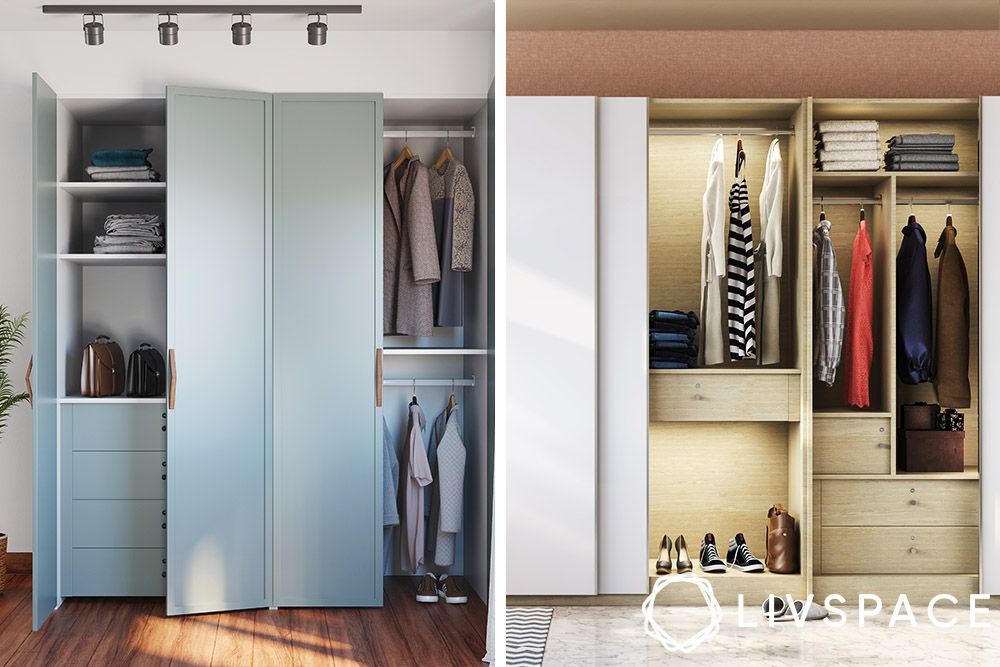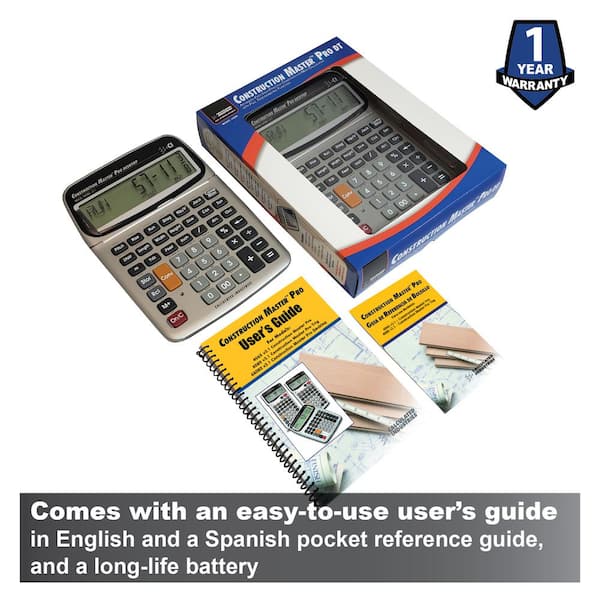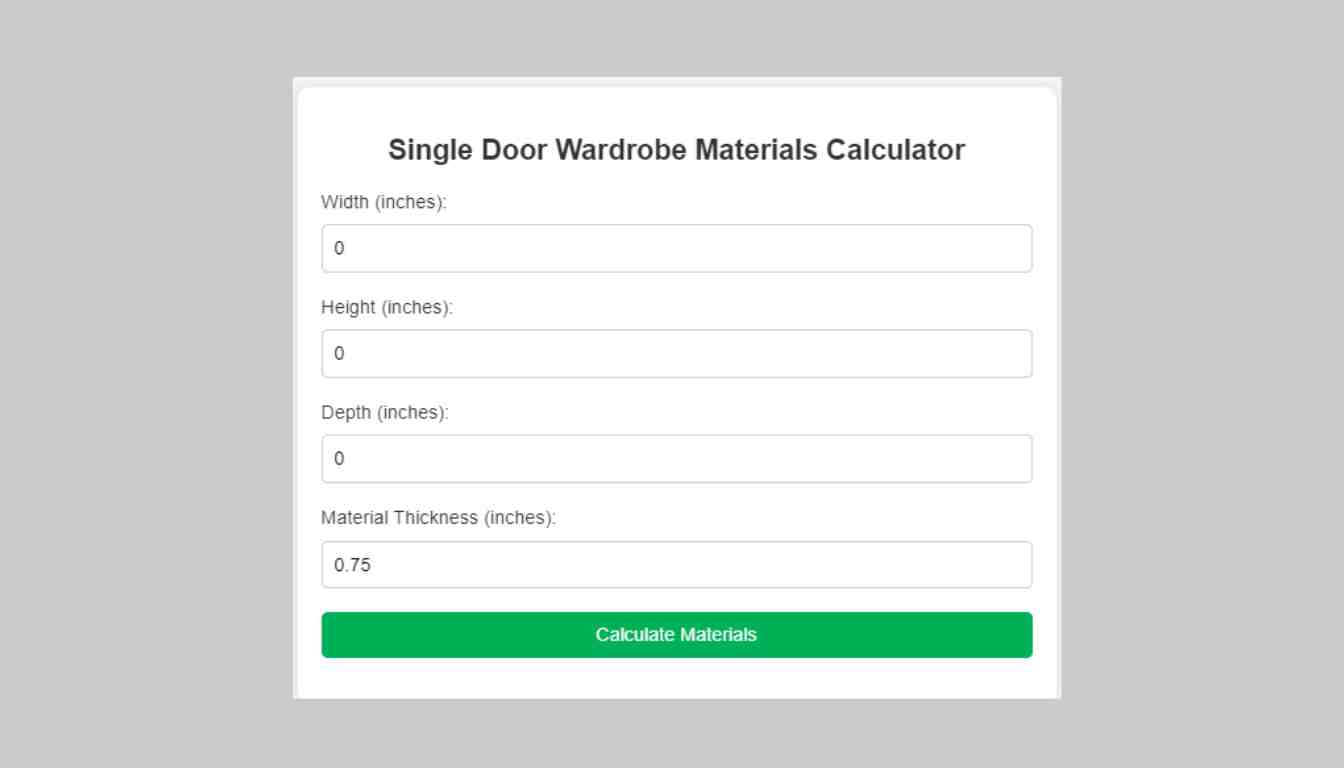To calculate single door wardrobe materials, measure the wardrobe’s height, width, and depth. Then determine the type of material and its thickness for accuracy.
Single Door Wardrobe Materials Calculator
A single door wardrobe is a functional and space-saving addition to any bedroom or storage area, allowing for organized and accessible clothing storage. Selecting the right materials for a single door wardrobe ensures durability and aesthetics, suiting the room’s decor and user needs.
Materials commonly used for wardrobes include wood, MDF, plywood, and laminate, each offering different visual appeals and longevity. Accurate calculations help avoid waste and ensure a cost-effective project, making a wardrobe calculator an invaluable tool for both DIY enthusiasts and professional carpenters. Precise measurements dictate the quantity of materials required and the overall structural integrity of the finished wardrobe.

Credit: www.livspace.com
Introduction To Single Door Wardrobe Design
Welcome to the world of custom wardrobe design, where every inch counts and style meets functionality. Building a single door wardrobe is both a practical and aesthetic choice. Whether it’s for a small city apartment or a compact room, the design process requires careful planning and precision. This guide embarks on the crucial journey of selecting the right materials, integral to your wardrobe’s durability and appearance.
Importance Of Proper Material Calculation
Getting the material calculation right is the cornerstone for efficiency and cost-effectiveness. An accurate calculation ensures you buy the right amount of material, neither too much nor too little. It prevents waste, saves money, and guarantees the stability and structure of your wardrobe are optimized for performance.
Common Types Of Wardrobe Materials
Different materials can dramatically alter the look, feel, and longevity of your single door wardrobe. Explore the options and choose one that aligns with your décor and durability requirements:
- Plywood: Versatile and resistant to warping, a popular choice.
- MDF (Medium Density Fiberboard): Smooth finish and great for paint customizations.
- Particle Board: Cost-effective with decent durability.
- Solid Wood: Timeless appeal and highly durable.
- Metal: Contemporary and offers a sleek look.
- Glass: Adds depth and a modern touch when combined with other materials.
Key Measurements For Single Door Wardrobes
Choosing the right single door wardrobe involves understanding key measurements.
These measurements help maximize space and ensure your wardrobe fits perfectly.
This guide will walk you through the standard dimensions and how to tailor them.
Measure twice, buy once for the best fit!
Standard Dimensions
Single door wardrobes are popular for their compact size and simplicity.
The typical wardrobe width ranges from 18 inches to 24 inches.
Most stand about 72 inches tall and extend roughly 24 inches in depth.
These dimensions serve as a great starting point.
| Component | Measurement (inches) |
|---|---|
| Width | 18 – 24 |
| Height | 72 |
| Depth | 24 |
Customizing For Space Constraints
In rooms where space is at a premium, customization is key.
Adjusting a wardrobe’s dimensions can make it blend seamlessly into the space.
Opt for a slimmer design or a reduced height to fit under eaves or in corners.
Always account for the swing of the door when measuring.
- Measure the intended space for width, height, and depth.
- Consider leaving extra inches for the door to open comfortably.
- Remember that customized wardrobes can often utilize awkward spaces efficiently.
A material calculator for single door wardrobes further simplifies the process.
After determining your dimensions, use the calculator for an accurate list of what you need.
This can include everything from timber to hinges and handles.
Efficient use of materials saves time and money!
Wood Varieties For Wardrobe Construction
Choosing the right wood is important. Your wardrobe’s look, durability, and feel depend on the wood type. Let’s explore the types of wood for building a wardrobe that balances beauty and functionality.
Hardwood Vs. Softwood
Hardwoods like oak and walnut are tough. They resist scratches and dents. These woods often come with unique patterns making wardrobes stand out.
Softwoods like pine are lighter and cost-effective. They are great for simple, budget-friendly wardrobes.
| Hardwood Types | Softwood Types |
|---|---|
| Oak | Pine |
| Walnut | Fir |
| Maple | Cedar |
Sustainable Wood Options
Eco-friendly choices make a difference. Look for FSC-certified wood confirming sustainable harvesting. Reclaimed woods are also ideal as they reduce environmental impact.
- Bamboo – Fast-growing and durable
- Rubberwood – Often a by-product of rubber production
- Lyptus – Grows quickly and requires less land
Engineered Wood And Its Advantages
Engineered wood is the star of modern furniture making, especially in crafting durable single door wardrobes. Unlike solid wood, this material offers uniform strength and comes at a friendlier cost. It’s adaptable to various finishes and less prone to warping. Now, let’s explore two popular types: MDF and plywood.
Mdf And Plywood Basics
Medium Density Fiberboard (MDF) and plywood stand out in the world of engineered wood. MDF is formed from wood fibers bonded with resin. It presents a smooth surface perfect for painting. Plywood consists of thin wood veneers glued together, offering great strength. Consider these materials for your wardrobe.
| Material | Features | Best Use |
|---|---|---|
| MDF | Smooth, no knots, easy to paint | Interior panels, decorative projects |
| Plywood | Layers, durable, resists warping | Frames, shelves, high-use areas |
Balancing Cost And Quality
Finding the sweet spot between cost and quality matters. MDF is budget-friendly and offers a fine finish. Plywood is more expensive but provides unmatched durability. Here’s what to consider:
- Use: Determine daily wear and tear.
- Finish: Decide on the look you want.
- Budget: Know what you can spend.
Weigh these factors to choose the right material. Both MDF and plywood have unique advantages for your single door wardrobe project.
Metal And Glass Elements
When considering materials for a single door wardrobe, don’t overlook metal and glass. These elements add sleek modernity and enhance the design. They ensure durability and elegance. Their combination creates a unique furniture piece, both eye-catching and practical.
Incorporating Metal Frames
Metal frames offer strong support for wardrobes. They’re resilient against wear and tear. This makes them ideal for long-lasting furniture. Metal frames contribute to a wardrobe’s sturdy structure. They can withstand heavy usage. Their sleek lines bring a contemporary edge to the design. Here’s how to incorporate metal frames:
- Measure the wardrobe’s height, width, and depth to determine the amount of metal needed.
- Select a metal type, such as aluminum or steel, based on weight and durability preferences.
- Choose a finish like matte, gloss, or brushed to complement the room’s décor.
Using Glass For Aesthetics And Function
Glass elements in a wardrobe merge beauty with utility. Glass doors allow a peek inside while keeping dust away. They can reflect light, making a room appear larger. Consider these points while using glass:
| Type of Glass | Pros | Cons |
|---|---|---|
| Tempered | Strong, safe on breakage | More expensive |
| Laminated | Soundproof, UV resistant | Can delaminate over time |
| Frosted | Privacy, diffuses light | Can show fingerprints |
For glass in wardrobes, thickness is key. Choose a thickness that offers stability without making the doors too heavy to slide. Balance transparency and opacity to suit both style and privacy needs.

Credit: www.woodworkers.ie
Calculating Material Quantities
Building a single door wardrobe begins with calculating material quantities. Perfect planning helps you save money and time. It’s vital for buying exactly what you need. Let me guide you through this process.
Formulae For Wood Cuts
Creating a wardrobe requires precise wood cuts. Use these formulae:
- Height: Measure from floor to ceiling. Subtract 5mm for clearance. Use this for side panels.
- Width: Decide how wide your wardrobe should be. This is for the top, bottom, and door.
- Depth: Standard is 600mm. It works for most hangers and folded clothes.
Let’s calculate for a wardrobe of 2 meters in height, 1 meter in width, and 0.6 meters in depth:
| Part | Measurements | Quantity |
|---|---|---|
| Sides | 2000mm (H) x 600mm (D) | 2 |
| Top/Bottom | 1000mm (W) x 600mm (D) | 2 |
| Door | 2000mm (H) x 1000mm (W) | 1 |
Estimating Hardware And Fixings
Hardware is crucial for your wardrobe’s function. You’ll need:
- Hinges: Calculate one hinge per 30cm of door height. A 200cm door needs at least 6-7 hinges.
- Screws: Get 40mm screws for wood attachments. Estimate around 20 for a small wardrobe.
- Handles: Pick a handle that complements your door size and material.
- Rails and Shelves: Depending on your design, estimate the number and types of fixings.
Always buy a little extra to cover any mistakes or damages.
Tools And Equipment For Material Preparation
Creating a single door wardrobe from scratch requires the right set of tools and equipment. Before embarking on this project, it’s vital to ensure you have all necessary items for material preparation. Proper tools lead to precise measurements and cuts, and safety equipment protects you throughout the process. Let’s break down what you’ll need to get started.
Machinery And Hand Tools
To shape and size the materials for your wardrobe, you’ll need a mix of machinery and hand tools:
- Table Saw: For straight cuts in wood.
- Measuring Tape: Essential for accurate measurements.
- Drill: To create holes for screws and handles.
- Sander: For smooth finishes on all surfaces.
- Hammer: Necessary for nail fittings.
- Screwdriver Set: For various screw types and sizes.
Familiarize yourself with each tool for the best results.
Safety Equipment
Personal safety cannot be compromised. Use the list below to protect yourself:
- Gloves: Protect your hands from splinters and cuts.
- Safety Goggles: Keep your eyes safe from dust and debris.
- Ear Protection: Use when operating loud machinery.
- Dust Mask: Prevent inhalation of harmful particles.
Ensure to wear these safety items at all times. Stay safe and work efficiently.
Finishing Materials For Wardrobes
The final look of your single door wardrobe hinges on the finishing materials you choose. These not only enhance the wardrobe’s aesthetic but also provide protection. With the right finishes, your wardrobe will stand out in both style and durability. Let’s dive into how to select the best paints and varnishes and understand the costs involved in these finishing materials.
Choosing Paints And Varnishes
Selecting the right paint or varnish for your wardrobe can be a game-changer. Here are pointers to consider:
- Material Compatibility: Check if the paint or varnish works with your wardrobe’s material.
- Durability: Look for options that offer long-lasting protection.
- Finish: Decide between a matte, semi-gloss, or glossy finish based on your style preference.
- Eco-Friendliness: Consider products with low VOC levels for healthier indoor air quality.
- Application Ease: Some products are easier to apply than others, so choose based on your skill level.
Costs Of Finishing Materials
The cost of finishing materials can vary widely. Here’s a breakdown to help you budget:
| Material | Price Range |
|---|---|
| Latex Paint | $15-$50 per gallon |
| Oil-Based Paint | $20-$60 per gallon |
| Water-Based Varnish | $20-$40 per quart |
| Polyurethane Varnish | $10-$30 per quart |
Note that higher quality finishes typically come at a higher price but offer better durability and appearance.
Budgeting Your Wardrobe Materials
Building a single door wardrobe requires careful planning and budgeting. The cost of materials can vary widely, so understanding your options and knowing how to calculate the expenses is crucial. Here we’ll explore effective cost estimation techniques and share some valuable tips for minimizing expenses.
Cost Estimation Techniques
Correctly estimating the cost of materials for your wardrobe prevents surprises. Start with these steps:
- List all materials needed, including wood, screws, and hinges.
- Measure the dimensions of the wardrobe to determine quantities.
- Consult with suppliers for current prices or use online cost calculators.
Create a spreadsheet to track and update costs as prices change.
Tips For Minimizing Expenses
Saving money without compromising quality is key. Consider these tips:
- Choose cost-effective materials that still meet your durability needs.
- Buy in bulk where possible to benefit from discounts.
- Look for deals or sales at hardware stores and online retailers.
- Reuse or repurpose materials if they’re in good condition.
Selecting the right materials and suppliers can lead to substantial savings. Be vigilant about sales and don’t shy away from negotiating prices.
Step-by-step Guide To Using The Materials Calculator
Building a single-door wardrobe requires precise planning and materials estimation. Our Materials Calculator simplifies this task. Follow our step-by-step guide for a seamless experience.
Inputting Data
Begin by measuring your space. Note down the height, width, and depth of your desired wardrobe.
Access the calculator. Look for the section labeled ‘Single Door Wardrobe’ on our website.
Enter your measurements in the designated fields. Be sure to adjust for units, whether inches or centimeters.
- Select materials you plan to use, from plywood to MDF.
- Pick your finish, like laminate or veneer.
- Remember to include extras like handles or mirrors.
Once all information is filled in, click ‘Calculate’.
Interpreting Results
The calculator processes your inputs and returns a detailed list of required materials.
You’ll see quantities for the main structure and the number of fixtures needed.
Add more rows as needed
| Material | Quantity |
|---|---|
| Plywood Sheets | 2 |
| Hinges | 4 |
Review the list. Double-check quantities and consider wastage or errors.
- Assess the summary of costs.
- Make necessary adjustments in the input if your budget requires it.
- Use the list for shopping or to request a quote from suppliers.
Save or print the results for your reference.
Common Pitfalls In Material Calculation
When planning to build a single door wardrobe, precise material calculation is crucial.
It ensures the project runs smoothly and stays within budget. Several pitfalls can disrupt
the process, leading to waste or a sudden dash to the store. Let’s explore how to combat common issues in material estimation.
Avoiding Underestimation
Underestimating materials can derail any wardrobe construction project. It leads to unexpected shopping trips and
project delays. To prevent this:
- Double-check measurements before purchasing.
- Consider potential obstacles like walls not being totally straight.
- Consult with professionals when in doubt.
Accurate plans and a little extra material can save a lot of time. Aim for precision but plan for minor errors.
Dealing With Surplus Materials
Surplus materials may result from over-purchase. This might seem harmless but it affects the budget.
- Store surplus for future repairs or projects.
- Sell or donate excess to recoup costs.
- Return unused materials if the store policy allows.
Smart planning involves minimal excess, yet remaining flexible for unexpected needs.

Credit: www.homedepot.com
Appendix: Resources And Further Reading
Welcome to the ‘Appendix: Resources and Further Reading’ section of our blog post. Here, you will find valuable information on suppliers and educational resources. They will assist you in choosing the best materials for your single-door wardrobe project. Use these resources as a guide to make smarter choices for your DIY venture.
Material Suppliers
Finding quality materials is crucial for your single-door wardrobe. Below is a list of reputable suppliers:
- Home Improvement Stores: Ideal for a wide range of materials and tools.
- Local Timber Yards: Perfect for wood selections with expert advice.
- Online Marketplaces: Convenient options with customer reviews.
- Specialty Hardware Stores: For unique fixtures and fittings.
Diy Wardrobe Design Books
Enhance your skills with DIY wardrobe design books. They offer step-by-step instructions. Check out these titles:
| Book Title | Author |
|---|---|
| Wardrobe Craftsmanship Simplified | John A. Carpenter |
| Small Closet Solutions | Lisa Cleary |
| The Complete Guide to DIY Wardrobes | Emma Right |
| Functional Furniture: A Wardrobe Project | Mark B. Buildwright |
Frequently Asked Questions Of Single Door Wardrobe Materials Calculator
What Materials Are Needed For A Single Door Wardrobe?
Materials typically include wood (MDF, plywood, solid wood), screws, hinges, handle, and sometimes a lock. Veneer or paint may also be required for finishing.
How To Calculate Materials For A Wardrobe?
Calculate based on wardrobe dimensions. Include door, sides, top, bottom, and back panel measurements. Factor in shelves and extra features to estimate material quantity accurately.
Can I Use Recycled Materials For A Wardrobe?
Yes, recycled materials like reclaimed wood or metal can be used for eco-friendly wardrobes. Ensure they are structurally sound and suit the intended design.
What Is The Cost Of Building A Single Door Wardrobe?
The cost depends on material choice and size. Expect to spend between $100 to $500 for DIY projects. Professional installation may increase the cost.
Conclusion
Crafting your perfect single-door wardrobe starts with precise calculations. This guide ensures you’ve got every angle covered. For those embarking on a DIY project or updating interiors, our materials calculator is indispensable. Arm yourself with exact measurements and set sail towards your bespoke storage solution, confident and well-prepared.
Let’s build beautifully!


